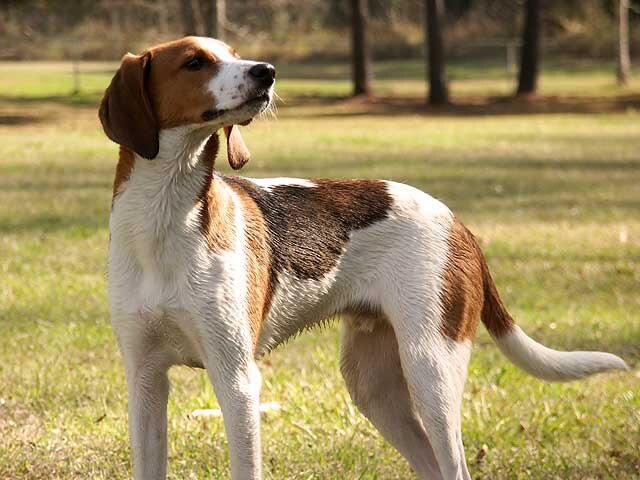


The Treeing Walker Coonhound is a highly energetic and skilled scent hound known for its hunting ability, particularly its talent for treeing raccoons and other small game. This breed is renowned for its speed, endurance, and acute sense of smell, making it an excellent choice for both professional hunters and active families. Treeing Walker Coonhounds are affectionate and loyal dogs, often forming strong bonds with their owners. While they are independent and have a strong prey drive, they are also known to be friendly, intelligent, and highly trainable with the right approach.
The Treeing Walker Coonhound has its roots in the United States, where it was developed in the 19th century. The breed is a descendant of the Walker Hound, which was originally bred for hunting foxes and raccoons. The "treeing" aspect of their name comes from their ability to chase a game animal up a tree, alerting their owners to the prey's location. The Treeing Walker Coonhound is believed to have been developed by selectively breeding dogs that exhibited superior hunting and tracking skills, particularly for treeing raccoons. The breed quickly became popular with hunters due to its speed, determination, and excellent sense of smell. It was officially recognized by the United Kennel Club (UKC) in 1900 and later by the American Kennel Club (AKC) in 2012. Today, the breed is primarily used for hunting but is also valued as a loyal companion for active families.
The Treeing Walker Coonhound is a medium to large-sized dog with an athletic, lean build. Males typically weigh between 50 and 70 pounds (23 to 32 kg), while females weigh between 40 and 60 pounds (18 to 27 kg). They stand 22 to 27 inches (56 to 69 cm) tall at the shoulder. Their coat is short, smooth, and dense, often in a tri-color pattern of black, white, and tan, though other color variations can occur. The breed has long, floppy ears, a broad head, and a deep, muscular chest. Their eyes are usually dark and expressive, with an intelligent and determined look. The tail is long and carried high, typically with a slight curve, and is often in motion, especially when they are excited or alert.
The Treeing Walker Coonhound is a friendly and loyal dog, known for its affectionate nature toward its family. They are typically good with children and can get along with other dogs if properly socialized. While they are not generally aggressive, their strong prey drive means they may be inclined to chase small animals such as squirrels, rabbits, or even cats, so supervision and early training are key. They are intelligent dogs and can be independent at times, making them well-suited for experienced dog owners who are patient and consistent. Though they are independent and focused when hunting, they are also playful, sociable, and loving companions when at home. They tend to be vocal, using their distinctive baying bark to alert their owners to a treeed animal, making them excellent watchdogs, though they may not be suited for apartment living due to their vocal nature.
The Treeing Walker Coonhound is an active and energetic breed that requires a lot of exercise to stay healthy and happy. This breed has high stamina and enjoys long walks, jogs, or runs. They are natural hunters and love activities that engage their sense of smell, such as scent tracking and searching. They thrive in environments where they can run and explore, such as large yards, rural properties, or outdoor spaces where they can be safely off-leash. If not given enough physical exercise, they may become bored and engage in undesirable behaviors. In addition to physical activity, mental stimulation is important for the Treeing Walker Coonhound, and they enjoy puzzle toys or games that challenge their scenting and problem-solving abilities. It's important to provide them with consistent exercise to maintain their fitness and prevent restlessness.
Training a Treeing Walker Coonhound requires patience, consistency, and positive reinforcement. While they are intelligent and eager to please, they can also be independent and may not always respond immediately to commands, especially when they are distracted by a scent. Early socialization is essential to ensure they are comfortable around other dogs, pets, and people. They can be somewhat stubborn, so training should be firm but gentle, with rewards such as treats or praise for good behavior. Since they have a strong prey drive, it is important to train them on recall and obedience, especially in situations where they might be tempted to chase small animals. With the right approach, they can be well-mannered and responsive, making them good companions both in the field and at home.
The Treeing Walker Coonhound is generally a healthy breed, but like all dogs, they can be prone to certain health issues. Some common concerns include hip dysplasia, ear infections (due to their floppy ears), and eye issues such as progressive retinal atrophy (PRA). Regular veterinary check-ups, a balanced diet, and routine exercise are essential to maintaining their health. The breed's short coat is relatively low-maintenance, requiring only occasional brushing to keep it clean and free of debris. Due to their long ears, it is important to check them regularly for signs of infection and to keep them clean and dry. Keeping up with regular vaccinations, flea and tick prevention, and dental care is also important to ensure the dog's overall well-being.
The average lifespan of a Treeing Walker Coonhound is between 12 and 14 years. With proper care, including regular exercise, a nutritious diet, and routine vet visits, many Treeing Walker Coonhounds live long and healthy lives. As they age, it is important to monitor their joints and overall health, particularly because they are an active breed that enjoys running and hunting. Keeping their weight under control and maintaining regular veterinary checkups can help ensure they remain healthy well into their senior years.
© copyright Dog Compendium 2024 - 2025